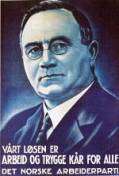Johan Nygaardsvold
| Johan Nygaardsvold | |
|---|---|
 | |
| Prime Minister of Norway | |
|
In office 20 March 1935 – 25 June 1945 | |
| Monarch | Haakon VII |
| Preceded by | Johan Ludwig Mowinckel |
| Succeeded by | Einar Gerhardsen |
| Personal details | |
| Born |
13 March 1879 Hommelvik, Norway |
| Died |
9 September 1952 (aged 73) Trondheim, Norway |
| Political party | Labour Party |
| Religion | Church of Norway |
Johan Nygaardsvold (Norwegian pronunciation: [ˈnyːɡoːrsvɔl]; 6 September 1879 - 13 March 1952) was a Norwegian politician from the Labour Party. He was Prime Minister of Norway from 1935 to 1945 (from 1940 to 1945 in exile in London), as head of the cabinet Nygaardsvold.[1]
Political career
Nygaardsvold was born in Hommelvik, the main center of the municipality of Malvik in the county of Sør-Trøndelag to a tenant farmer and his wife. His father was a founding member of the first labor union in the area, and Johan took his first job as a lumber mill worker when he was 12.

Nygaardsvold emigrated to Canada in 1902, where he took the name John Westby. He took jobs in British Columbia in Canada, and Kalispell, Montana, and Spokane, Washington in USA before returning to Norway in 1907, having followed a career as an Industrial Workers of the World agitator. In 1910, he was elected to the board of education for the Labour Party, and rose quickly through the ranks in local politics. In 1916, he was elected to the Norwegian parliament for the first time, serving continuously until 1949. He worked as a laborer in the Swedish lumber industry during the summers in the first few years. From 1920 to 1922 he served as the mayor for his home town of Malvik.
In 1928, Nygaardsvold was appointed minister of agriculture in the short-lived Christopher Hornsrud cabinet. From 11 January 1934 to 20 March 1935 he served as President of the Storting. In 1935, Nygaardsvold was asked to form a government. He served as prime minister until the Nazi Germany attack on Norway 9 April 1940, when the government fled to London. He continued as prime minister in exile until the government returned to Norway on 31 May 1945 and resigned on 25 June, when Haakon VII appointed Einar Gerhardsen to head an interim government composed of all political parties. He retired from politics in 1949 and died of cancer in 1952.
A number of progressive reforms were instituted during Nygaardsvold's time as prime minister. The old Age Insurance Law of July 1936, for isntance, introduced national pension insurance, while the Unemployment Insurance Law of June 1938 introduced compulsory unemployment insurance for all employees and workers outside the primary sector “who were compulsorily insured under the sickness insurance scheme; means-tested benefits; those with incomes above or below certain levels not entitled to benefits.”[2]
Historical legacy
Known as "Gubben" ("the old man") in his time, Nygaardsvold had immense popular appeal and was given credit for the Labour Party's election results in 1933. Nygaardsvold was the prime minister in the second Labour Party cabinet in Norway, after he helped formulate the so-called "crisis accord" with the Farmers' Party. His government's domestic policy was largely dedicated to recovering from the Great Depression, but it is most noted for its foreign and military policy in the years leading up to the occupation of Norway by Nazi Germany and his administration in exile from 1940 to 1945. The investigative commission that issued a report after the war found that he could not be absolved from responsibility for the lack of operational readiness for the German invasion, but gave him credit for his management of a unity government in exile. He was awarded an honorary salary for his service in exile, but refused to accept it.
Nygaardsvold announced in 1942 that he would resign as soon as the war ended, which he did.
Notes
- ↑ Nygaardsvold, along with his cabinet as well as the entire parliament, resided in exile in London during World War II while Norway was occupied by Nazi Germany. In parts of this period Vidkun Quisling, leader of the nationalist/fascist political party Nasjonal Samling, assumed a degree of formal power, but in reality the country was governed by the occupants, represented by Reichskommissar Josef Terboven.
- ↑ Growth to limits: the Western European welfare states since World War 2: Volume 4 by Peter Flora
| Political offices | ||
|---|---|---|
| Preceded by Johan Ludwig Mowinckel |
Prime Minister of Norway 1935–1945 |
Succeeded by Einar Gerhardsen |
| ||||||||||||||||||||||||
| ||||||
|